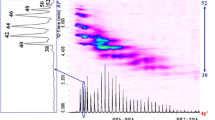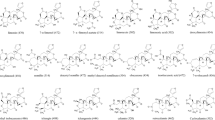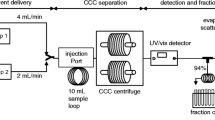Abstract
The effect of the γ-linolenic acid (18:3n-6) residue on the elution of triacylglycerols on a 25% cyanopropyl-25% phenyl-50% methylpolysiloxane stationary phase was confirmed by using capillary supercritical fluid chromatography-atmospheric pressure chemical ionization mass spectrometry [cSFC-(APCI)MS]. The general elution rule on this stationary phase is that triacylglycerols having the same ACN+2n value coeluted (ACN-acyl carbon number and n=combined number of double bonds in the acyl chains). The different effect of γ- and α-linolenic acid residues on the retention of triacylglycerols and the use of cSFC-(APCI)MS allowed the study of the number of different linolenic acid residue isomer combinations in triacylglycerols with an identical ACN and degree of unsaturation. Stearidonic acid (18:4n-3) residue was found to have a similar effect on the retention behavior of triacylglycerols as that of γ-linolenic acid residue. The abundance of the [M-RCOO]+ ion, formed by the loss of one fatty acid moiety of a triacylglycerol, was found to be clearly higher in the case of γ-isomer of the linolenic acid than that of α-isomer in the identical regiospecific position. This indicates that the distance of the double bonds from the glycerol backbone in the acyl chain affects the stability of a triacylglycerol molecule in the (APCI)MS system. The triacylglycerol composition and the fatty acid combinations of triacylglycerols were found to be almost identical in black currant (Ribes nigrum) and alpine currant (R. alpinum) seed oils.
Similar content being viewed by others
Abbreviations
- ACN:
-
acyl carbon number
- APCI:
-
atmospheric pressure chemical ionization
- (APCI)MS:
-
APCI mass spectrometry
- cSFC:
-
capillary supercritical fluid chromatography
- FID:
-
flame-ionization detector
- LC:
-
liquid chromatography
References
Horrobin, D.F. (1992) Nutritional and Medical Importance of Gamma-Linolenic Acid, Prog. Lipid Res. 31, 163–194.
Huang, Y.-S., and Mills, D.E. (1996) γ-Linolenic Acid-Metabolism and Its Roles in Nutrition and Medicine, AOCS Press, Champaign.
Manninen, P., Laakso, P., and Kallio, H. (1995) Separation of γ- and α-Linolenic Acid Containing Triacylglycerols by Capillary Supercritical Fluid Chromatography, Lipids 30, 665–671.
Manninen, P., Laakso, P., and Kallio, H. (1995) Method for Characterization of Triacylglycerols and Fat-Soluble Vitamins in Edible Oils and Fats by Supercritical Fluid Chromatography, J. Am. Oil Chem. Soc. 72, 1001–1008.
Manninen, P., and Laakso, P. (1997) Capillary Supercritical Fluid Chromatography-Atmospheric Pressure Chemical Ionization Mass Spectrometry of Triacylglycerols in Berry Oils, J. Am. Oil Chem. Soc., in press.
Byrdwell, W.C., and Emken, E.A. (1995) Analysis of Triglycerides Using Atmospheric Pressure Chemical Ionization Mass Spectrometry, Lipids 30, 173–175.
Neff, W.E., and Byrdwell, W.C. (1995) Soybean Oil Triacylglycerol Analysis by Reversed-Phase High-Performance Liquid Chromatography Coupled with Atmospheric Pressure Chemical Ionization Mass Spectrometry, J. Am. Oil Chem. Soc. 72, 1185–1191.
Byrdwell, W.C., Emken, E.A., Neff, W.E., and Adlof, R.O. (1996) Quantitative Analysis of Triglycerides Using Atmospheric Pressure Chemical Ionization-Mass Spectrometry, Lipids 31, 919–935.
Laakso, P., and Voutilainen, P. (1996) Analysis of Triacylglycerols by Silver-Ion High-Performance Liquid Chromatography-Atmospheric Pressure Chemical Ionization Mass Spectrometry, Lipids 31, 1311–1322.
Ruiz-Gutierrez, V., and Barron, L.J.R. (1995) Methods for the Analysis of Triacylglycerols, J. Chromatogr. B 671 133–168.
Christie, W.W. (1988) Separation of Molecular Species of Triacylglycerols by High-Performance Liquid Chromatography with a Silver-Ion Column, J. Chromatogr. 454, 273–284.
Perrin, J.-L., Prevot, A., Traitler, H., and Bracco, U. (1987) Analysis of Triglyceride Species of Black Currant Seed Oil by HPLC via a Laser Light Scattering Detector, Rev. Fr. Corps Gras, 34, 221–226.
Aitzetmüller, K., and Grönheim, H. (1992) Separation of Highly Unsaturated Triacylglycerols by Reversed-Phase HPLC with Short Wavelength UV Detection, J. High Resolut. Chromatogr. 15, 219–226.
Author information
Authors and Affiliations
About this article
Cite this article
Manninen, P., Laakso, P. Capillary supercritical fluid chromatography-atmospheric pressure chemical ionization mass spectrometry of γ- and α-linolenic acid containing triacylglycerols in berry oils. Lipids 32, 825–831 (1997). https://doi.org/10.1007/s11745-997-0105-1
Received:
Revised:
Accepted:
Issue Date:
DOI: https://doi.org/10.1007/s11745-997-0105-1




